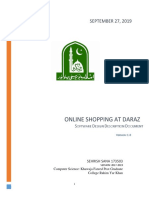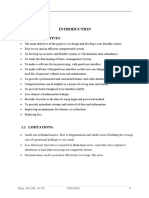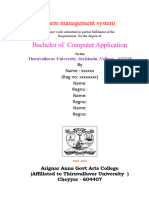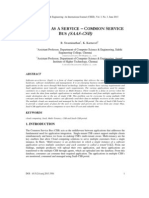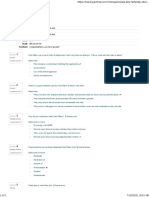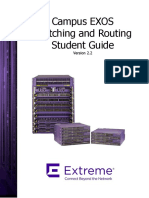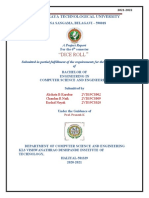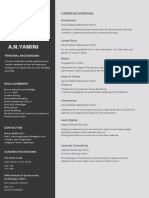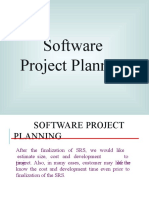Metro Flow Chart
Metro Flow Chart
Uploaded by
Shaival PimplikarCopyright:
Available Formats
Metro Flow Chart
Metro Flow Chart
Uploaded by
Shaival PimplikarOriginal Title
Copyright
Available Formats
Share this document
Did you find this document useful?
Is this content inappropriate?
Copyright:
Available Formats
Metro Flow Chart
Metro Flow Chart
Uploaded by
Shaival PimplikarCopyright:
Available Formats
Vol-3 Issue-5 2017 IJARIIE-ISSN(O)-2395-4396
THE METRO RAILWAY MANAGEMENT
Abin Karmakar1, Deep Saha2
1
Under Graduate Student, Department of Information Technology, SRM University, Tamil Nadu, India
2
Under Graduate Student, Department of Information Technology, SRM University, Tamil Nadu, India
ABSTRACT
The system manages public feedback among services through its complain management system. Thus the system
will also be containing an online ticket recharge module where users can recharge their smart cards online through
the site .There is also an admin module where admin will be able to add stations . The trains routes and also update
the fares. The admin should be a panel consisting of a group of authorized persons.
1. INTRODUCTION
This is an integrated service which provide all information about the metro rail and it’s routes for public. The
proposed system is a web based application which provides information regarding timings, routes, fair. This system
manages public feedback about services through it’s complaint management system. This system also contains an
online ticket recharge module where users can recharge their smart cards online through the site. There is also an
admin module where admin can add stations, trains, routes and also update the fairs. The admin is a panel
consisting of a group of authorized persons.
1.1 Existing System
In existing system there are flaws which really makes it an important issue to develop it. Some of them are
information cannot be collected, processed and communicated more quickly and efficiently. Current working
systems doesn’t ensure that right information reaches the right person at the right time.
1.2 Solution to these problems
The proposed system is designed to eliminate the disadvantages of the existing system. The proposed system
“Metro Rail Management System” is mentioned for tracing the problems in the existing system. Increased
efficiency and reliability, easier Access. Easy to use, provide accurate information to the user for taking necessary
decisions, accuracy-The information will be correct, accurate and unambiguous, efficiency-information can be
collected, processed and communicated more quickly and efficiently, systems ensure that right information reaches
the right person at the right time, reliability-since systems are free from boredom and tiredness, they work
constantly on data to produce more reliable outputs, accessibility, usability and understandability, the options used
can be easily accessed, used and realized.
2. CONVINIENCE STUDY
System design is the solution for the creation of a new system.
This phase focuses on the detailed implementation of the feasible system. It emphasis on translating design
specifications to performance specification. System design has two phases of development
Logical design
6853 www.ijariie.com 1565
Vol-3 Issue-5 2017 IJARIIE-ISSN(O)-2395-4396
Physical design
During logical design phase the analyst describes inputs (sources), output s(destinations), databases (data
sores) and procedures (data flows) all in a format that meets the user requirements. The analyst also specifies the
needs of the user at a level that virtually determines the information flow in and out of the system and the data
resources. Here the logical design is done through data flow diagrams and database design. The physical design is
followed by physical design or coding. Physical design produces the working system by defining the
design specifications, which specify
exactly what the candidate system must do.The programmers write the necessary programs that accept input
from the user, perform necessary processing on accepted data and produce the required report on a hard copy or
display it on the screen.
2.1 Theoretical Convenience
DATABASE DESIGN:
Databases are the storehouses of data used in the software systems. The data is stored in tables inside the
database. Several tables are created for the manipulation of the data for the system. Two essential settings
for a database are
Primary Key- the field that is unique for all the record occurrences.
Foreign Key-the field used to set relation between tables.
Normalization is a technique to avoid redundancy in the tables.
2.2 Operational Convenience
The various system tools that have been used in developing both the front end and the back end of the project are
being discussed in this chapter.
Front End: JSP, HTML, CSS, JAVA SCRIPTS are utilized to implement the frontend.
Java Server Pages (JSP)
Different pages in the applications are designed using jsp. A Java Server Pages component is a type of Java servlet
that is designed to fulfil the role of a user interface for a Java web application. Web developers write JSPs as text
files that combine HTML or XHTML code, XML elements, and embedded JSP actions and commands. Using JSP,
one can collect input from users through web page.
HTML (Hyper Text Markup Language)
HTML is a syntax used to format a text document on the web.
CSS (Cascading Style Sheets)
CSS is a style sheet language used for describing the look and formatting of a document written in a
markup language.
6853 www.ijariie.com 1566
Vol-3 Issue-5 2017 IJARIIE-ISSN(O)-2395-4396
Java Script
JS is a dynamic computer programming language. It is most commonly used as part of web browsers, whose
implementations allow client-side scripts to interact with the user, control the browser, communicate
asynchronously, and alter the document content that is displayed.
Back End: The back end is implemented using MySQL which is used to design the databases.
MySQL
MySQL is the world's second most widely used open-source relational database management system
(RDBMS). The SQL phrase stands for Structured Query Language.
An application software called wamp was used to design the tables in MySQL.
3. SYSTEM DESIGN
System Design is the design that depicts all the working of a system. These designs are the plans and the work flows
through which the desired system is to be constructed. Some of the diagrams that are to be discussed are architecture
of the system, use case diagram and activity diagram.
3.1 Architecture
Architecture is the basic working unit of a system. The different diagrams of the system are as follows:
Fig -1:Complaint Management
As we can observe from the above diagram reply for is the medium between complaints and the reply. When a
complaint is to be registered addresses, email, messages, customer id as well as phone number is fetched or is
obtained. And the reply mechanism works with the help of customer id and reply id with a reply message.
6853 www.ijariie.com 1567
Vol-3 Issue-5 2017 IJARIIE-ISSN(O)-2395-4396
Fig -2: Route and Trip Management
From the above figure(fig-2), the entire route and trip management that is the architectural
design of trains available, routes, stations, timings of train, details of the trip is explained.
3.2 Use Case Diagrams
A use caseDiagram) is a structured analysis and design tool that can be used for flowcharting. A is a network
that describes the flow of data and the processes that change or transform the data throughout a system.
This network is constructed by using a set of symbols that do not imply any physical implementation.
So it is the starting point of the design phase that functionally decomposes the requirements specifications down
to the lowest level of detail. DFD can be considered to an abstraction of the logic of an information-
oriented or a process-oriented system flowchart. For these reasons DFD’s are often referred to as logical data
flow diagrams.
EXTERNAL ENTITY
An external entity is a source or destination of a data flow. Only those entities which originate or receive data are
represented on a data flow diagram. The symbol used is a rectangular box.
PROCESS
A process shows a transformation or manipulation of data flow within the system. The symbol used is an oval
shape.
DATAFLOW
The data flow shows the flow of information from a source to its destination. Data flow is represented by a
line, with arrowheads showing the direction of flow. Information always flows to or from a process and
may be written, verbal or electronic. Each data flow may be referenced by the processes or data stores at
its head and tail, or by a description of its contents.
DATA STORE
A data store is a holding place for information within the system: It is represented by an open ended narrow
rectangle. Data stores may be long-term files such as sales ledgers, or may be short-term accumulations: for
example batches of documents that are waiting to be processed. Each data store should be given a reference
followed by an arbitrary number.
DATA FLOW DIAGRAM FOR COMPLAINT MANAGEMENT SYSTEM
6853 www.ijariie.com 1568
Vol-3 Issue-5 2017 IJARIIE-ISSN(O)-2395-4396
Fig 3: Complaint management system DFD
USE CASE DIAGRAM FOR ONLINE TICKET RECHARGE
Fig 4.1.
Fig 4.2
6853 www.ijariie.com 1569
Vol-3 Issue-5 2017 IJARIIE-ISSN(O)-2395-4396
DATA FLOW DIAGRAM FOR METRO TIME TABLE
Fig 5: Metro time table DFD
DATA FLOW DIAGRAM FOR FAIR & ROUTE MAP
Fig 6: Fair and route map DFD
6853 www.ijariie.com 1570
Vol-3 Issue-5 2017 IJARIIE-ISSN(O)-2395-4396
3.3 Activity Diagram
Fig 7: Activity Diagram
The above figure(fig:7) holds the the activity of the system resembling the admin module. An activity diagram
generally is the the activity by which it can be known how the system is going to act based on the changes made by
the admin.
4. CONCLUSIONS
The system has been developed with much care and free of errors and at the same time it is efficient and less time
consuming. The purpose of this project was to develop a web application for metro rail management . The entire
system is secured. Also the project helps one understand about the development phases of a project and software
development life cycle. Besides getting benefited for the knowledge gained this project is very useful in daily life
and can be efficiently implemented or worked upon.
5. ACKNOWLEDGEMENT
I would like to acknowledge our Project Guide for letting us proceed with the project topic as well as helping us
with the step by step method of the system, our Project Coordinator for providing us with the useful guidelines and
information about recent system types and modules and our Head Of The Department for granting us the
opportunity to perform a project as well as providing us the encouragement
6. REFERENCES
[1]. Oracle Academy
[2]. Wikipedia
[3]. Fundamentals of Database System by Ramez Elmasri
[4]. PHP and MySQL with Web Development by Luke Welling and Laura Thompson
6853 www.ijariie.com 1571
Vol-3 Issue-5 2017 IJARIIE-ISSN(O)-2395-4396
BIOGRAPHIES
Under graduate Student, Department of Information
Technology at SRM University, Ramapuram,
Chennai(Tamil Nadu)
Under graduate Student, Department of Information
Technology at SRM University, Ramapuram,
Chennai(Tamil Nadu)
6853 www.ijariie.com 1572
You might also like
- Railway Reservation Project ReportDocument29 pagesRailway Reservation Project ReportNaMan SeThi100% (1)
- ISO/IEC 27002 Implementation Guidance and MetricsDocument14 pagesISO/IEC 27002 Implementation Guidance and MetricsNoticeBored100% (19)
- Module 1 CC 101Document33 pagesModule 1 CC 101Piyo100% (1)
- Railway Management SystemDocument30 pagesRailway Management Systemrkjrocks33% (3)
- Sehrish Sana - Online Shopping at Daraz - SDDDocument99 pagesSehrish Sana - Online Shopping at Daraz - SDDRabiaNo ratings yet
- Assembler To Cobol ConversionDocument20 pagesAssembler To Cobol ConversionpoojagirotraNo ratings yet
- Airline Reservation Systems-Project SynopsisDocument23 pagesAirline Reservation Systems-Project Synopsisanusha palasaNo ratings yet
- Library Management System Project ReportDocument30 pagesLibrary Management System Project ReportKeshav Jatav100% (1)
- 17SCSE121004 - RAHUL NARAYAN TYAGI PROJECT 1 - Rahul Narayan TyagiDocument22 pages17SCSE121004 - RAHUL NARAYAN TYAGI PROJECT 1 - Rahul Narayan TyagiSuneet KhareNo ratings yet
- JewelDocument79 pagesJewelMichael WellsNo ratings yet
- A Software Architectural Design Method For Large-Scale Distributed Information SystemsDocument12 pagesA Software Architectural Design Method For Large-Scale Distributed Information SystemstakiiscNo ratings yet
- Appartment Visitor TrackingDocument15 pagesAppartment Visitor TrackingnizsamNo ratings yet
- Online Library ManagementDocument27 pagesOnline Library ManagementRishika GowdaNo ratings yet
- Online Railway Reservation System ReportDocument35 pagesOnline Railway Reservation System ReportVipul Sharma68% (19)
- 8system Design and DevelopmentDocument16 pages8system Design and DevelopmentSabNo ratings yet
- On Line Railway Reservation SystemDocument13 pagesOn Line Railway Reservation SystemU18CSD016No ratings yet
- Gftryfjhvhgv JJNKHKDocument38 pagesGftryfjhvhgv JJNKHKoliyadNo ratings yet
- Resource Allocation and Management in Cloud Based NetworksDocument5 pagesResource Allocation and Management in Cloud Based NetworksthesijNo ratings yet
- Manish Kuthe Project ReportDocument20 pagesManish Kuthe Project Reportkuthemanish4No ratings yet
- AbstractDocument106 pagesAbstractsameerkhan04843No ratings yet
- Statistics Collection and Workload Management of SQL QueriesDocument7 pagesStatistics Collection and Workload Management of SQL QueriesRachana MedehalNo ratings yet
- Mobile Shop Management System DocumentationDocument99 pagesMobile Shop Management System DocumentationVickram Jain50% (4)
- Library Management System Project ReportDocument51 pagesLibrary Management System Project Reporthardikpadhy63% (8)
- Object Oriented Software Engineering: L Ecture 3 3 Semester Department of Computer SC IenceDocument20 pagesObject Oriented Software Engineering: L Ecture 3 3 Semester Department of Computer SC IenceBabar ZafarNo ratings yet
- FORMANAGER: An Office Forms Management System: S. Bing Yao, Alan R. Hevner, Zhongzhi Shi, and Dawei LuoDocument28 pagesFORMANAGER: An Office Forms Management System: S. Bing Yao, Alan R. Hevner, Zhongzhi Shi, and Dawei Luojhonmarc.floresNo ratings yet
- Chapter: Architecture & User Interface DesignDocument26 pagesChapter: Architecture & User Interface DesignJaher WasimNo ratings yet
- An Automated System For Patient Record ManagementDocument7 pagesAn Automated System For Patient Record ManagementRonnie Oliva MalalisNo ratings yet
- SD Exp2 - 13 - b3Document34 pagesSD Exp2 - 13 - b3MIHIR PATELNo ratings yet
- Microfinancing SoftwareDocument9 pagesMicrofinancing SoftwareNeerajNo ratings yet
- ETCW03Document3 pagesETCW03Editor IJAERDNo ratings yet
- Project Report FileDocument25 pagesProject Report FileTanzeela GhanchiNo ratings yet
- Car InventoryDocument62 pagesCar InventoryNayan Prakash SinghNo ratings yet
- DBMS & TbaDocument8 pagesDBMS & Tbaatia khanNo ratings yet
- Blood Bank Management System SYNOPSISDocument10 pagesBlood Bank Management System SYNOPSISRishabh ShuklaNo ratings yet
- BDMS Final Proj ReportDocument24 pagesBDMS Final Proj ReportSakshi RNo ratings yet
- Chapter Three GuideDocument13 pagesChapter Three Guideusmangaji500No ratings yet
- Big Data Approach For Secure Traffic Data Analytics Using HadoopDocument4 pagesBig Data Approach For Secure Traffic Data Analytics Using HadoopEditor IJRITCCNo ratings yet
- AyushDocument25 pagesAyushayushchoudhary20289No ratings yet
- Bus Pass RenewalDocument15 pagesBus Pass RenewalnizsamNo ratings yet
- Towards Flexibility in A Distributed Data Mining Framework: Jos e M. Pe Na Ernestina MenasalvasDocument4 pagesTowards Flexibility in A Distributed Data Mining Framework: Jos e M. Pe Na Ernestina MenasalvasShree KanishNo ratings yet
- Unit Iv Function and Service Oriented DesignsDocument51 pagesUnit Iv Function and Service Oriented DesignsDeebika KaliyaperumalNo ratings yet
- Timetable GeneratorDocument16 pagesTimetable GeneratorTaha Ali100% (1)
- Employee Management System: School of Mathematics and Systems EngineeringDocument65 pagesEmployee Management System: School of Mathematics and Systems EngineeringVivek BhardwajNo ratings yet
- City PortalDocument18 pagesCity Portalಅಪೂರ್ವ ಚಂದ್ರಶೇಖರ್No ratings yet
- Report 2Document33 pagesReport 2AdarshaNo ratings yet
- Marksheet-Generation System: Synopsis OnDocument24 pagesMarksheet-Generation System: Synopsis OnVicky Kanojiya0% (1)
- Structured Analysis and Structured Design 3Document7 pagesStructured Analysis and Structured Design 3Vandana BhartiNo ratings yet
- Farm Mangement ConvDocument40 pagesFarm Mangement Convlozzby0No ratings yet
- mini project report_20241205_132106_0000Document4 pagesmini project report_20241205_132106_0000anakhasanthosh204No ratings yet
- Mini - Project BtbsDocument17 pagesMini - Project Btbssuhas kolliparaNo ratings yet
- Chapter-1: Employee Management SystemDocument78 pagesChapter-1: Employee Management SystemMariraju health centerNo ratings yet
- (Mariwan) 40-Article Text-99-1-10-20200207 PDFDocument10 pages(Mariwan) 40-Article Text-99-1-10-20200207 PDFHoshmand MoradNo ratings yet
- Railway Reservation SystemDocument18 pagesRailway Reservation Systempoovizhi27beNo ratings yet
- Client Server ArchitectureDocument25 pagesClient Server ArchitectureShibin MohamedNo ratings yet
- Project Report On Real EstateDocument26 pagesProject Report On Real EstateAmit SharmaNo ratings yet
- Ip ProjectDocument64 pagesIp Projectpriya manchu50% (18)
- DbmspblfinalDocument19 pagesDbmspblfinalVijay KumarNo ratings yet
- S A AS - C S B: (Saas-Csb)Document6 pagesS A AS - C S B: (Saas-Csb)John BergNo ratings yet
- Report - e HealthDocument46 pagesReport - e HealthAPCACNo ratings yet
- Matrimonial Portal DocumentDocument11 pagesMatrimonial Portal DocumentthangatpNo ratings yet
- Application Design: Key Principles For Data-Intensive App SystemsFrom EverandApplication Design: Key Principles For Data-Intensive App SystemsNo ratings yet
- Real-Time Analytics: Techniques to Analyze and Visualize Streaming DataFrom EverandReal-Time Analytics: Techniques to Analyze and Visualize Streaming DataNo ratings yet
- Design Automation of Cyber-Physical SystemsFrom EverandDesign Automation of Cyber-Physical SystemsMohammad Abdullah Al FaruqueNo ratings yet
- The Evolution of Cybersecurity - Web Filter QuizDocument2 pagesThe Evolution of Cybersecurity - Web Filter Quizchhun50% (4)
- A Computer Maintenance and Repair A CompDocument15 pagesA Computer Maintenance and Repair A CompEphrem ChernetNo ratings yet
- Riscv Privileged BCN.v7 2Document45 pagesRiscv Privileged BCN.v7 2hobomanNo ratings yet
- Mini Project Report: Body MeterDocument35 pagesMini Project Report: Body MeterSoham ShindeNo ratings yet
- Cloud Enabling TechnologyDocument103 pagesCloud Enabling TechnologySahithi NamalaNo ratings yet
- Jhumki Barat Career Objectives: SkillsDocument2 pagesJhumki Barat Career Objectives: SkillsJhumkiNo ratings yet
- Ext Xoss&r SG 22Document463 pagesExt Xoss&r SG 22edmoxaNo ratings yet
- An of Firewall Technologies: KeywordsDocument8 pagesAn of Firewall Technologies: Keywordsrajvaibhav nimbalkarNo ratings yet
- "Dice Roll": Visvesvaraya Technological UniversityDocument17 pages"Dice Roll": Visvesvaraya Technological UniversitykushalNo ratings yet
- Service Informatique Montreal 24H IT Support Cybersécurité SOFTFLOW Cybersecurity Managed IT Services ProviderDocument41 pagesService Informatique Montreal 24H IT Support Cybersécurité SOFTFLOW Cybersecurity Managed IT Services ProviderService Informatique Montreal 24H IT Support CyberNo ratings yet
- B.E CseDocument13 pagesB.E CsePulihora Kat RajaNo ratings yet
- Chapter 8 - Part 2Document16 pagesChapter 8 - Part 2Saeed KhawamNo ratings yet
- Unveiling Your KeystrokesDocument51 pagesUnveiling Your KeystrokesPrakash Chandra100% (1)
- Linux Rapid Compromise Assessment 2Document64 pagesLinux Rapid Compromise Assessment 2Nidaul Muiz AufaNo ratings yet
- A.N.Yamini: Career BackgroundDocument1 pageA.N.Yamini: Career BackgroundAbhishek SrivastavaNo ratings yet
- Spark by SumitDocument33 pagesSpark by SumitS HARI KRISHNANo ratings yet
- ITIL® Awareness - ITIL V3 Question and Answers - TrenovisionDocument13 pagesITIL® Awareness - ITIL V3 Question and Answers - TrenovisionSriNo ratings yet
- Capstone Project (Revised)Document6 pagesCapstone Project (Revised)Marco Ramos100% (2)
- KUKA SunriseFRI 116 enDocument62 pagesKUKA SunriseFRI 116 enMatyas TakacsNo ratings yet
- CS314 Lab2Document7 pagesCS314 Lab2Ruchi Tuli WadhwaNo ratings yet
- How To Apply For A Federal Funding Opportunity On Grants - Gov - Grants - Gov Community BlogDocument3 pagesHow To Apply For A Federal Funding Opportunity On Grants - Gov - Grants - Gov Community BlogTuhin DeyNo ratings yet
- Operating SystemsDocument19 pagesOperating SystemsGovind ShankarNo ratings yet
- CSS Assignment One SolutionsDocument4 pagesCSS Assignment One Solutionskarthikrajakarthikraja372No ratings yet
- Chapter 4 Software Project PlanningDocument194 pagesChapter 4 Software Project PlanningPrabhat SharmaNo ratings yet
- Chapter-2 Data ScienceDocument21 pagesChapter-2 Data ScienceNejib ReshadNo ratings yet
- Manual On Primary & Secondary Storage DevicesDocument12 pagesManual On Primary & Secondary Storage DevicesTajay SegreeNo ratings yet




